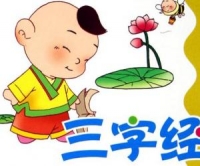蒙学 》 Three Character Classic 》
三字经
Wang Yinglin
 三字经 三字经
【Notes】
《三字经》的内容分为六个部份,每一部份有一个中心。
从“人之初,性本善”到“人不学,不知义”,讲述的是教育和学习对儿童成长的重要性,后天教育及时,方法正确,可以使儿童成为有用之材;
从“为人学,方少时”至“首孝悌,次见闻”强调儿童要懂礼仪要孝敬父母、尊敬兄长,并举了黄香和孔融的例子;
从“知某数,识某文”到“此十义,人所同”介绍的是生活中的一些名物常识,有数字、三才、三光、三纲、四时、四方、五行、五常、六谷、六畜、七情、八音、九族、十义,方方面面,一应俱全,而且简单明了;
从“凡训蒙,须讲究”到“文中子,及老庄”介绍中国古代的重要典籍和儿童读书的程序,这部份列举的书籍有四书、六经、三易、四诗、三传、五子,基本包括了儒家的典籍和部份先秦诸子的著作;
从“经子通,读诸史”到“通古今,若亲目”讲述的是从三皇至清代的朝代变革,一部中国史的基本面貌尽在其中;
从“口而诵,心而维”至“戒之哉,宜勉力”强调学习要勤奋刻苦、孜孜不倦,只有从小打下良好的学习基础,长大才能有所作为,“上致君,下泽民”。
《三字经》内容的排列顺序极有章法,体现了作者的教育思想。作者认为教育儿童要重在礼仪孝悌,端正孩子们的思想,知识的传授则在其次,即“首孝悌,次见闻”。训导儿童要先从小学入手,即先识字,然后读经、子两类的典籍。经部子部书读过后,再学习史书,书中说:“经子通,读诸史”。
《三字经》最后强调学习的态度和目的。可以说,《三字经》既是一部儿童识字课本,同时也是作者论述启蒙教育的著作,这在阅读时需加注意。
《三字经》用典多,知识性强,是一部在儒家思想指导下编成的读物,充满了积极向上的精神。
《三字经》的版本很多,清朝道光年间刊行的版本是最通行的一种。我们采用的则是民国年间的增补本。
《三字经》中的故事
孟母三迁
昔孟子少时,父早丧,母仉[zhang]氏守节。居住之所近于墓,孟子学为丧葬,[足辟] [bi,两字合一]踊痛哭之事。母曰:“此非所以居子也。”乃去,舍市,近于屠,孟子学为买卖屠杀之事。母又曰:“亦非所以居子也。”继而迁于学宫之旁。每月朔[shuo,夏历每月初一日]望,官员入文庙,行礼跪拜,揖[yi,拱手礼]让进退,孟子见了,一一习记。孟母曰:“此真可以居子也。”遂居于此。
孟母断机
孟母姓仉(zhang)氏,孟子之母。夫死,狭子以居,三迁为教。及孟子稍长,就学而归,母方织,问曰:“学何所至矣?”对曰:“自若也。”母愤因以刀断机,曰:“子之废学,犹吾之断斯机也。”孟子惧,旦夕勤学,遂成亚圣。
五子登科
《宋史·窦仪传》记载:宋代窦禹钧的五个儿子仪、俨、侃、偁、僖相继及第,故称“五子登科”。
五代后周时期,燕山府(今北京一带)有个叫窦禹钧的人,记取祖训,教导儿子们仰慕圣贤,刻苦学习,为人处世,不愧不怍。结果,他的五个儿子都品学兼优,先后登科及第:
窦禹钧本人也享受八十二岁高寿,无疾而终。当朝太师冯道还特地写了首诗:“燕山窦十郎,教子有义方;灵椿一株老,丹桂五技芳。”
《三字经》也以“窦燕山,有义方,教五子,名俱扬”的句子,歌颂此事;又逐渐演化为“五子登科”的吉祥图案,寄托了一般人家期望子弟都能像窦家五子那样连袂获取功名。
黄香温席
昔汉时黄香,江夏人也.年方九岁,知事亲之理.每当夏日炎热之时,则扇父母帷帐,令枕清凉,蚊蚋远避, 以待亲之安寝;至于冬日严寒,则以身暖其亲之衾,以待亲之暖卧.于是名播京师,号曰"天下无双,江夏黄香"
孔融让梨
孔融的父亲拿一些梨给孩子们吃,让孔融先挑,孔融却挑了一个最小的。父亲问他为什么拿最小的,孔融回答,自己最小,所以应该吃小的,大的给哥哥吃。这故事被用作儿童教育的好教材,成为千古美谈,它美就美在孔融小小年纪便有如此谦让风格。
孔融(153~208),东汉文学家。字文举。鲁国(今山东曲阜)人。灵帝时,辟司徒杨赐府。中平初(185),举高第,为侍御史。后辟司空府为僚属,拜中军候,迁虎贲中郎将。后因忤董卓,转为议郎,出至黄巾军最盛的青州北海郡为相。兴平二年(195)领青州刺史。曹操迁献帝都许昌,征孔融为将作大匠,迁少府。因不满曹操雄诈,被奏免官。后复拜太中大夫,退居闲职,好士待客,座上客满,奖掖推荐,声望甚高。终为曹操所忌,下狱弃市。
孔融著有,《隋书·经籍志》载《孔融集》9卷,已散佚。通行本有《汉魏六朝百三家集·孔少府集》1卷。孔融文又见严可均《全上古三代秦汉三国六朝文·全后汉文》,其诗又见丁福保《全汉三国晋南北朝诗·全汉诗》。
苏洵二十七方才学习
苏洵(1009~1066),字明允,自号老泉,北宋眉山人,北宋著名散文家。在妻子程氏的劝告下,27岁才开始发奋读书,经过十多年的闭门苦读,学业大进。嘉祐元年,携子苏轼、苏辙到汴京,以22篇文章谒见欧阳修,受其赏识,由此名声大振。后人因其二子苏轼、苏辙均以文学闻名,故称他为“老苏”,将他们父子三人合称为“三苏”,均列入唐宋八大家。苏洵为文见解精辟,语言锋利,纵横扌卑阖,很有战国纵横家的风度。著有《嘉祐集》十五卷。
请欣赏:
请给我换一个看看! 拜托,快把噪音停掉!我读累了,想听点音乐或者请来支歌曲!
|
|
|